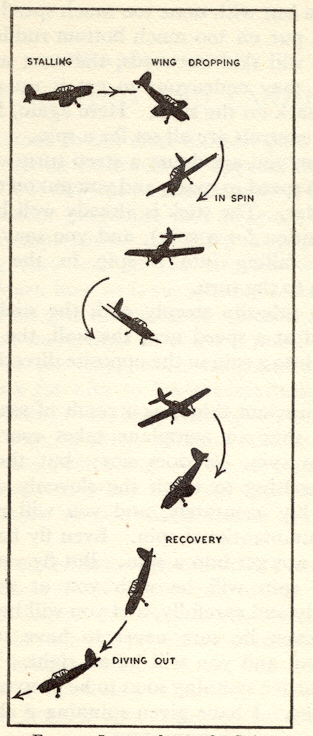 |
The Spin
When analysed; the spin is a complex
series of We learned that the stall is a function For this reason the aeroplane should be
loaded in |
In our last flight the wing dropped when we stalled the aeroplane, this is the beginning of the incipient (about to happen) spin!
 |
The Spin
When analysed; the spin is a complex
series of We learned that the stall is a function For this reason the aeroplane should be
loaded in |
Spinning the Cessna 152
It is a hallmark of the tricycle wheeled Cessna 150/152/172 aeroplanes that they are difficult to deliberately spin when they are loaded in compliance with the Utility Category Certification. Load a couple of passengers and some baggage into a Cessna 172 and it becomes easier to spin, but the aeroplane is not in the Utility Category! To learn what a spin is really like you need to fly one of the following aeroplanes: Piper Tomahawk, Slingsby T67, Chipmunk, Condor, or most 'classic' training aeroplanes.
We are flying the Cessna 152 however so let's look at how we can simulate the spin...
'Spin entry'
There are two ways to enter the spin in a Cessna 152, you either flick/snap the aeroplane in, or you enter with some power. Flicking it in is very violent, this is often the way that frightens the student pilot and involves reducing the speed to around 50KIAS and applying full up elevator and rudder violently. The aeroplane inverts and enters a spin.
The nicer entry is to apply 1500 RPM and at 40-45KIAS apply full rudder and up elevator, this way the aeroplane enters the auto-rotation smoothly. Once established you must close the throttle.
In the spin
The Cessna 152 will spin for one turn and then it enters a spiral dive, so one turn is all this author does with a student! It's enough to get the point across. The aeroplane rotates due to the differential lift of the wings because there is yaw, the faster wing is developing more lift and so rotates upwards, at the same time the nose is yawing in the same direction. The aeroplane descends like a sycamore seed.
The Cessna 152 will recover if it is correctly loaded, and the power is at idle, by simply releasing the controls.
The true spin
In an aerobatic aeroplane or a trainer with true spinning characteristics, the spin will stabilise after a turn or two. The stablised spin has several characteristics; the speed will be of a low value and will oscillate up and down, the rotation rate will be consistent, and the rate of descent will be steady. Positive recovery actions must be done to recover from the true spin.
"Recover, Recover, Recover"
This is the standard recovery technique:
Close the throttle, centralise the ailerons, apply full opposite rudder, pause, move the control column forward until the stall has been broken, Centralise the controls, and ease out of the dive.
Closing the throttle removes the slipstream
and gyroscopic effects that may increase the yaw.
We learned about adverse yaw in a previous lesson, so
centralising the ailerons also reduces the total yaw.
The rudder is for controlling yaw, the spin is all about yaw, so
applying opposite rudder is an excellent way of stopping the yaw
that is causing the rotation.
Pause to let the rudder take effect, the elevator might mask the
airflow over the rudder.
Now that we've taken care of the yaw, let's unstall the
aeroplane! Reducing the angle of attack by moving the control
column forward is the way.. In a true spinning aeroplane the rate
of rotation will increase before before it stops, this is because
the wing that is producing the most lift creates even more lift,
more quickly than the deeper stalled wing as its angle of attack
is reduced.
Once the rotation has stopped the controls are centralised.
Now ease the aeroplane gently out of the dive. Easing it means that you avoid reaching the stalling angle and hence a secondary stall.
The Spiral Dive is often perceived as being similar to the spin, it isn't! The Spiral Dive is described in the next lesson.
© Michael Peare 2001